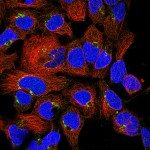Lien vers Pubmed [PMID] – 40067081
Lien DOI – 10.1152/physrev.00023.2024
Physiol Rev 2025 Mar; ():
Tunneling nanotubes (TNTs) are thin tubular membrane protrusions that connect distant cells, generating a complex cellular network. Over the past few decades, research on TNTs has provided important insights into their biology, including structural composition, formation mechanisms, modulators, and functionality. It has been discovered that TNTs allow cytoplasmic continuity between connected cells, facilitating fast intercellular communication via both passive or active exchange of materials. These features are pivotal in the nervous system, where rapid processing of inputs is physiologically required. TNTs have been implicated in the progression of neurodegenerative diseases and cancer in various in vitro models, while TNT-like structures have also been observed in the developing brain and in vivo. This highlights their significant role in pathophysiological processes. In this comprehensive review we aim to provide an extensive overview of TNTs, starting from key structural features and mechanisms of formation, and describing the main experimental techniques used to detect these structures both in vitroand in vivo. We focus primarily on the nervous system, where the discovery of TNTs could prompt a reconsideration of the brain functioning as individual units (the neuronal theory of Cajal) versus neurons being physically connected, as Golgi believed. We illustrate the involvement of TNTs in brain development and neurodegenerative states, and highlight the limitations and future research needs in this field.



